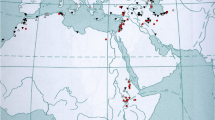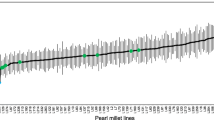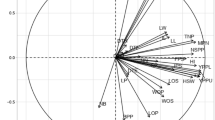Abstract
The present study was to identify the communities of B. tournefortii Gouan in Al-Jouf areas in northern Saudi Arabia, to determine soil factors controlling its genetic variability and its allelopathic control. The plant communities dominated by B. tournefortii were investigated in fifteen localities. A collection of fifteen Saudi Arabian B. tournefortii populations was evaluated using five morphological traits. Analysis of variance and correlation coefficient were performed based on R software package. Soils representing each community were analyzed using eleven physico-chemical parameters. The allelopathic effects of Portulaca oleracea and Pulicaria undulata and their mixtures on germination, seedling root and shoot growth of B. tournefortii were investigated. The dendrogram based on trait variation using UPGMA method, shows genetic difference between the studied populations. Genetic variability analysis showed a important variability of number of seeds per plant (cv = 19.522) and number of pods per plant (cv = 11.663). The water extracts of Portulaca oleracea and Pulicaria undulata could be applied at a concentration of 10 g/L for the management of this species.





Similar content being viewed by others
REFERENCES
Aldhebiani, A.Y. and Howladar, S.M., Floristic diversity and environmental relations in two valleys, south west Saudi Arabia, Int. J. Sci. Res., 2013, vol. 4, pp. 1916–1925.
VanTassel, H.L.H., Hansen, A.M., Barrows, C.W., Latif, Q., Simon, M.W., and Anderson, K.E., Declines in a ground-dwelling arthropod community during an invasion by Sahara mustard (Brassica tournefortii) in aeolian sand habitats, Biol. Invasions, 2014, vol. 16, pp. 1675–1687.
Chauhan, B.S., Gill, G., and Preston. C., African mustard (Brassica tournefortii) germination in southern Australia, Weed Sci., 2006, vol. 54, pp. 891–897.
Abella, S.R., Spencer, J.E., Hoines, J., and Nazarchyk, C., Assessing an exotic plant surveying program in the Mojave Desert, Clark County, Nevada, USA, Environ. Monit. Assess., 2019, vol. 151, pp. 221–230.
Australian Oilseeds Federation Crop Report, New South Wales, Australia, 2015.
Ahmed, D.A., Fawzy, M., Saeed, N.M., and Awad, M.A., Effect of the recent land use on the plant diversity and community structure of Omayed Biosphere Reserve, Egypt, Glob. Ecol. Conserv., 2015, vol. 4, pp. 26–37.
Singh, R., Semwal, D.P., and Bhatt, K.C., Characterization and evaluation of Asian mustard (Brassica tournefortii Gouan.): An endangered oilseed crop of northwestern India, Indian J. Plant Genet. Res., 2015, vol. 28, pp. 278–281.
Guarrera, P.M. and Savo, V., Wild food plants used in traditional vegetable mixtures in Italy. J. Ethnopharmacol., 2016, vol. 185, pp. 202–234.
Abd El-Gawad, A.M., Ecology and allelopathic control of Brassica tournefortii in reclaimed areas of the Nile Delta, Egypt, Turk. J. Bot., 2014, vol. 38, pp. 347–357.
Winkler, D.E., Gremer, J.R., Chapin, K.J., Kao, M., and Huxman, T.E., Rapid alignment of functional trait variation with locality across the invaded range of Sahara mustard (Brassica tournefortii), Am. J. Bot., 2018, vol. 105, no. 7, pp. 1–10.
Huxman, T.E., Kimball, S., Angert, A.L., Gremer, J.R., Barron-Gafford, J.A., Venable, D.L., Understanding past, contemporary, and future dynamics of plants, populations, and communities using Sonoran Desert winter annuals, Am. J. Bot., 2013, vol. 100, pp. 1369–1380.
Mahajan, G., Mutti, N.K., Jha, P., Walsh, M., and Chauhan, B.S., Evaluation of dormancy breaking methods for enhanced germination in four biotypes of B tournefortii,Sci. Rep., 2018, vol. 8, pp.171–183.
Gomaa, N.H., Composition and diversity of weed communities in Al-Jouf province, northern Saudi Arabia, Saudi J. Biol. Sci., 2012, vol. 19, pp. 369–376.
Piper, C.S., Soil and Plant Analysis, Adelaide, SA: Univ. of Adelaide, 1974.
Jackson, M.L., Soil Chemical Analysis: Advanced Course, Madison, WI: Dept. of Soil Sci., Univ. of Wisconsin, 1962.
Jackson, M.L., Soil Chemical Analysis, London: Constable and Co. Ltd., 1958.
Rice, E.L., Allelopathic effcts of Andropogon virginicus and its persistence in old fields, Am. J. Bot., 1972, pp. 752–755.
El-Keblawy, A., Gairola, S., Dormancy-regulating chemicals alleviate innate seed dormancy and promote germination o f desert annuals, J. Plant Growth Regul., 2016, vol. 23, pp. 254–251.
Choudhary, B.R. and Joshi, P., Crossability of B. carinata and B. tournefortii, and cytomorphology of their F1 hybrid, Cytologia, 2012, vol. 77, no. 4, pp. 453–458.
Gorecki, M.J, Long, R.L., Flematti, G.R., and Stevens, J.C., Parental environment changes the dormancy state and karrikinolide response of Brassica tournefortii seeds, Ann. Bot., 2012, vol. 109, pp. 1369–1378.
Suazo, A.A., Spencer, J.E., Engel, E.C., and Abella, S.R., Responses of native and non-native Mojave Desert winter annuals to soil disturbance and water additions, Biol. Invasions, 2010, vol. 14, pp. 215–227.
Trader, M.R., Brooks, M.L., and Draper, J.V., Seed production by the non-native Brassica tournefortii (Sahara mustard) along desert roadsides, Madroño, 2006, vol. 53, pp. 313–320.
Kaletha, M.S., Bhatt, B.P., and Todaria, N.P., Allelopathic cropweed interactions in traditional agroforestry systems of Garhwal Himalaya, Allelopathy J., 1996, vol. 3, pp. 65–75.
Corsato, J.M., Fortes, A.M.T., Santorum, M., Leszczynski, R., Efeito alelopático do extrato aquoso de folhas de girassol sobre a germinação de soja e picão-preto, Semina: Ciênc. Agrár. (Londrina), 2010, vol. 31, pp. 353–360.
Anjum, T. and Pajwa, R., Importance of germination indices in interpretation of allelochemical effects. Int. J. Agric. Biol., 2005, vol. 3, pp. 417–419.
Shehata, H.F., Allelopathic potential of Portulaca oleracea L. seed extracts on germination and seedling growth of Cichorium endivia L., Lactua sativa L., Echinochloa Crus-Galli L., and Brassica Tournefortii Gouan, J. Exp. Biol. Agric. Sci., 2014, vol. 2, no. 4, pp. 338–396.
Serafimov, P., Sabev, V., and Golubinova, I., Inhibiting effect of water extract from black nightshade (Solanum nigrum L.) on the initial germinability of soybean seeds, in Collection of Scientific Reports from the Jubilee Scientific Conference on Selection and Technological Aspects of Production and Processing of Soybeans and Other Legumes, September 8,2005, Pavlikeni, 2005, pp. 100–106.
Mardani, R., Yousefi, A.R., and Fotovat, R., Using image analysis to study the response of wild barley to different concentrations of wheat aqueous extract, Int. J. Agric. Res. Rev., 201, vol. 2, pp. 774–782.
Liu, Y., Chen, X., Duan, S., Feng, Y., and An, M., Mathematical modeling of plant allelopathic hormesis based on ecological-limiting factor models, Dose-Response, 2011, vol. 9, pp. 117–129.
El-Ghareeb, R.M., Suppression of annuals by Tribulus terrestris in an abandoned field in the sandy desert of Kuwait, J. Veg. Sci., 1991, vol. 2, pp. 47–154.
Hasegawa, K., Togo, S., Urashima, M., Mizutani, J., Kosemura, S., and Yamamura, S., An auxin-inhibiting substance from lightgrown maize shoots, Phytochemistry, 1992, vol. 2, pp. 3673–3676.
Einhellig, F.A., Mechanism of action of allelochemicals in allelopathy, Agron. J., 1996, vol. 88, pp. 886–893.
Author information
Authors and Affiliations
Corresponding author
Ethics declarations
The authors declare that they have no conflict of interest. This article does not contain any studies involving animals or human participants performed by any of the authors.
Supplementary material
Rights and permissions
About this article
Cite this article
Naghmouchi, S., Alsubeie, M. Influence of the Allelopathic Properties of the Soils on the Genetic, Physiological and Morphological Parameters of Brassica tournefortii from Different Populations in Northern Saudi Arabia. Russ J Ecol 51, 233–241 (2020). https://doi.org/10.1134/S106741362003011X
Received:
Revised:
Accepted:
Published:
Issue Date:
DOI: https://doi.org/10.1134/S106741362003011X




